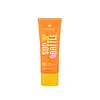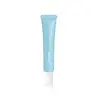What's inside
What's inside
 Key Ingredients
Key Ingredients

 Benefits
Benefits

 Concerns
Concerns

 Ingredients Side-by-side
Ingredients Side-by-side

Water
Skin ConditioningEthylhexyl Methoxycinnamate
UV AbsorberNiacinamide
SmoothingCetearyl Olivate
Butyl Methoxydibenzoylmethane
UV AbsorberPhenoxyethanol
PreservativeDipropylene Glycol
HumectantHydroxyethyl Acrylate/Sodium Acryloyldimethyl Taurate Copolymer
Emulsion StabilisingPPG-3 Benzyl Ether Myristate
EmollientButyrospermum Parkii Butter
Skin ConditioningButylene Glycol
HumectantSorbitan Olivate
EmulsifyingAluminum Starch Octenylsuccinate
AbsorbentOctocrylene
UV AbsorberAcrylates/C10-30 Alkyl Acrylate Crosspolymer
Emulsion StabilisingChlorphenesin
AntimicrobialPropylene Glycol
HumectantAminomethyl Propanol
BufferingParfum
MaskingAllantoin
Skin ConditioningTetrasodium EDTA
Glycyrrhiza Glabra Root Extract
BleachingGlycerin
HumectantLecithin
EmollientMentha Piperita Leaf Extract
Skin ConditioningPolysorbate 60
EmulsifyingDimethicone
EmollientDimethicone/Vinyl Dimethicone Crosspolymer
Skin ConditioningGlycereth-20
HumectantPentylene Glycol
Skin ConditioningAmodimethicone
Carbomer
Emulsion StabilisingDisodium EDTA
Sodium Hydroxide
BufferingBHT
AntioxidantPotassium Sorbate
PreservativeSodium Benzoate
MaskingArbutin
AntioxidantCitric Acid
BufferingSodium Sulfite
PreservativeAcetyl Tyrosine
Skin ConditioningSaxifraga Sarmentosa Extract
Skin ConditioningPaeonia Suffruticosa Root Extract
Skin ProtectingAminopropyl Ascorbyl Phosphate
AntioxidantScutellaria Baicalensis Root Extract
AstringentGlutathione
Water, Ethylhexyl Methoxycinnamate, Niacinamide, Cetearyl Olivate, Butyl Methoxydibenzoylmethane, Phenoxyethanol, Dipropylene Glycol, Hydroxyethyl Acrylate/Sodium Acryloyldimethyl Taurate Copolymer, PPG-3 Benzyl Ether Myristate, Butyrospermum Parkii Butter, Butylene Glycol, Sorbitan Olivate, Aluminum Starch Octenylsuccinate, Octocrylene, Acrylates/C10-30 Alkyl Acrylate Crosspolymer, Chlorphenesin, Propylene Glycol, Aminomethyl Propanol, Parfum, Allantoin, Tetrasodium EDTA, Glycyrrhiza Glabra Root Extract, Glycerin, Lecithin, Mentha Piperita Leaf Extract, Polysorbate 60, Dimethicone, Dimethicone/Vinyl Dimethicone Crosspolymer, Glycereth-20, Pentylene Glycol, Amodimethicone, Carbomer, Disodium EDTA, Sodium Hydroxide, BHT, Potassium Sorbate, Sodium Benzoate, Arbutin, Citric Acid, Sodium Sulfite, Acetyl Tyrosine, Saxifraga Sarmentosa Extract, Paeonia Suffruticosa Root Extract, Aminopropyl Ascorbyl Phosphate, Scutellaria Baicalensis Root Extract, Glutathione
Water
Skin ConditioningGlycerin
HumectantPropylene Glycol
HumectantEthylhexyl Salicylate
UV AbsorberOctocrylene
UV AbsorberDiethylamino Hydroxybenzoyl Hexyl Benzoate
UV FilterButyl Methoxydibenzoylmethane
UV AbsorberGlycereth-26
HumectantTremella Fuciformis Polysaccharide
Emulsion StabilisingButylene Glycol
HumectantEthylhexyl Triazone
UV AbsorberDimethicone
EmollientPotassium Cetyl Phosphate
Emulsifying1,2-Hexanediol
Skin ConditioningHydroxyacetophenone
AntioxidantCI 77891
Cosmetic ColorantDiglycerin
HumectantAcrylates/C10-30 Alkyl Acrylate Crosspolymer
Emulsion StabilisingPEG/PPG-17/6 Copolymer
SolventPolysorbate 80
EmulsifyingTriethanolamine
BufferingPanthenol
Skin ConditioningVp/Va Copolymer
Paeonia Suffruticosa Root Extract
Skin ProtectingSorbitan Oleate
EmulsifyingGlyceryl Glucoside
HumectantAllantoin
Skin ConditioningNiacinamide
SmoothingAdenosine
Skin ConditioningGlycyrrhiza Uralensis Root Extract
Skin ConditioningPortulaca Oleracea Flower/Leaf/Stem Extract
AntioxidantPaeonia Lactiflora Extract
AstringentFicus Carica Fruit Extract
HumectantDianthus Chinensis Extract
HumectantGlucose
HumectantLactobacillus Ferment Lysate
Skin ConditioningAlumina
AbrasiveTriethoxycaprylylsilane
Bifida Ferment Lysate
Skin ConditioningAscorbic Acid
AntioxidantBrassica Campestris Sprout Extract
HumectantTriticum Vulgare Germ Extract
Skin ConditioningBrassica Oleracea Italica Sprout Extract
EmollientStreptococcus Thermophilus Ferment
HumectantCaprylic/Capric Triglyceride
MaskingPhenoxyethanol
PreservativeCentella Asiatica Extract
CleansingHydrogenated Lecithin
EmulsifyingHexylene Glycol
EmulsifyingStearic Acid
CleansingCholesterol
EmollientCeramide NP
Skin ConditioningCeramide AP
Skin ConditioningCeramide EOP
Skin ConditioningSodium Hyaluronate Crosspolymer
HumectantPotassium Hyaluronate
Skin ConditioningHydrolyzed Sodium Hyaluronate
Skin ConditioningHyaluronic Acid
HumectantSodium Hyaluronate Dimethylsilanol
HumectantEthylhexylglycerin
Skin ConditioningPhospholipids
Skin ConditioningSodium Hyaluronate
HumectantAstaxanthin
Skin ConditioningHydroxypropyltrimonium Hyaluronate
Sodium Acetylated Hyaluronate
HumectantHydrolyzed Hyaluronic Acid
HumectantWater, Glycerin, Propylene Glycol, Ethylhexyl Salicylate, Octocrylene, Diethylamino Hydroxybenzoyl Hexyl Benzoate, Butyl Methoxydibenzoylmethane, Glycereth-26, Tremella Fuciformis Polysaccharide, Butylene Glycol, Ethylhexyl Triazone, Dimethicone, Potassium Cetyl Phosphate, 1,2-Hexanediol, Hydroxyacetophenone, CI 77891, Diglycerin, Acrylates/C10-30 Alkyl Acrylate Crosspolymer, PEG/PPG-17/6 Copolymer, Polysorbate 80, Triethanolamine, Panthenol, Vp/Va Copolymer, Paeonia Suffruticosa Root Extract, Sorbitan Oleate, Glyceryl Glucoside, Allantoin, Niacinamide, Adenosine, Glycyrrhiza Uralensis Root Extract, Portulaca Oleracea Flower/Leaf/Stem Extract, Paeonia Lactiflora Extract, Ficus Carica Fruit Extract, Dianthus Chinensis Extract, Glucose, Lactobacillus Ferment Lysate, Alumina, Triethoxycaprylylsilane, Bifida Ferment Lysate, Ascorbic Acid, Brassica Campestris Sprout Extract, Triticum Vulgare Germ Extract, Brassica Oleracea Italica Sprout Extract, Streptococcus Thermophilus Ferment, Caprylic/Capric Triglyceride, Phenoxyethanol, Centella Asiatica Extract, Hydrogenated Lecithin, Hexylene Glycol, Stearic Acid, Cholesterol, Ceramide NP, Ceramide AP, Ceramide EOP, Sodium Hyaluronate Crosspolymer, Potassium Hyaluronate, Hydrolyzed Sodium Hyaluronate, Hyaluronic Acid, Sodium Hyaluronate Dimethylsilanol, Ethylhexylglycerin, Phospholipids, Sodium Hyaluronate, Astaxanthin, Hydroxypropyltrimonium Hyaluronate, Sodium Acetylated Hyaluronate, Hydrolyzed Hyaluronic Acid
Ingredients Explained
These ingredients are found in both products.
Ingredients higher up in an ingredient list are typically present in a larger amount.
Acrylates/C10-30 Alkyl Acrylate Crosspolymer is a synthetic polymer. It is used to thicken and improve the texture of products. Due to its properties, it can prevent water and oil ingredients from separating.
Allantoin is a soothing ingredient known for its protective and moisturizingg properties. Because of this, it is often added to products with strong active ingredients.
Studies show higher concentrations of this ingredient can promote wound healing.
Though it can be derived from the comfrey plant, allantoin is produced synthetically for cosmetic products to ensure purity.
Learn more about AllantoinAlso known as Avobenzone, this ingredient is a chemical sunscreen filter that provides protection in the UV-A range.
Avobenzone is globally approved and is the most commonly used UV-A filter in the world.
Studies have found that avobenzone becomes ineffective when exposed to UV light (it is not photostable; meaning that it breaks down in sunlight). Because of this, formulations that include avobenzone will usually contain stabilizers such as octocrylene.
However, some modern formulations (looking at you, EU!) are able to stabilize avobenzone by coating the molecules.
Avobenzone does not protect against the UV-B range, so it's important to check that the sunscreen you're using contains other UV filters that do!
The highest concentration of avobenzone permitted is 3% in the US, and 5% in the EU.
Learn more about Butyl MethoxydibenzoylmethaneButylene Glycol (or BG) is used within cosmetic products for a few different reasons:
Overall, Butylene Glycol is a safe and well-rounded ingredient that works well with other ingredients.
Though this ingredient works well with most skin types, some people with sensitive skin may experience a reaction such as allergic rashes, closed comedones, or itchiness.
Learn more about Butylene GlycolDimethicone is a type of synthetic silicone created from natural materials such as quartz.
What it does:
Dimethicone comes in different viscosities:
Depending on the viscosity, dimethicone has different properties.
Ingredients lists don't always show which type is used, so we recommend reaching out to the brand if you have questions about the viscosity.
This ingredient is unlikely to cause irritation because it does not get absorbed into skin. However, people with silicone allergies should be careful about using this ingredient.
Note: Dimethicone may contribute to pilling. This is because it is not oil or water soluble, so pilling may occur when layered with products. When mixed with heavy oils in a formula, the outcome is also quite greasy.
Learn more about DimethiconeGlycerin is already naturally found in your skin. It helps moisturize and protect your skin.
A study from 2016 found glycerin to be more effective as a humectant than AHAs and hyaluronic acid.
As a humectant, it helps the skin stay hydrated by pulling moisture to your skin. The low molecular weight of glycerin allows it to pull moisture into the deeper layers of your skin.
Hydrated skin improves your skin barrier; Your skin barrier helps protect against irritants and bacteria.
Glycerin has also been found to have antimicrobial and antiviral properties. Due to these properties, glycerin is often used in wound and burn treatments.
In cosmetics, glycerin is usually derived from plants such as soybean or palm. However, it can also be sourced from animals, such as tallow or animal fat.
This ingredient is organic, colorless, odorless, and non-toxic.
Glycerin is the name for this ingredient in American English. British English uses Glycerol/Glycerine.
Learn more about GlycerinNiacinamide is a multitasking form of vitamin B3 that strengthens the skin barrier, reduces pores and dark spots, regulates oil, and improves signs of aging.
And the best part? It's gentle and well-tolerated by most skin types, including sensitive and reactive skin.
You might have heard of "niacin flush", or the reddening of skin that causes itchiness. Niacinamide has not been found to cause this.
In very rare cases, some individuals may not be able to tolerate niacinamide at all or experience an allergic reaction to it.
If you are experiencing flaking, irritation, and dryness with this ingredient, be sure to double check all your products as this ingredient can be found in all categories of skincare.
When incorporating niacinamide into your routine, look out for concentration amounts. Typically, 5% niacinamide provides benefits such as fading dark spots. However, if you have sensitive skin, it is better to begin with a smaller concentration.
When you apply niacinamide to your skin, your body converts it into nicotinamide adenine dinucleotide (NAD). NAD is an essential coenzyme that is already found in your cells as "fuel" and powers countless biological processes.
In your skin, NAD helps repair cell damage, produce new healthy cells, support collagen production, strengthen the skin barrier, and fight environmental stressors (like UV and pollution).
Our natural NAD levels start to decline with age, leading to slower skin repair, visible aging, and a weaker skin barrier. By providing your skin niacinamide, you're recharging your skin's NAD levels. This leads to stronger, healthier, and younger looking skin.
Another name for vitamin B3 is nicotinamide. This vitamin is water-soluble and our bodies don't store it. We obtain Vitamin B3 from either food or skincare. Meat, fish, wheat, yeast, and leafy greens contain vitamin B3.
The type of niacinamide used in skincare is synthetically created.
Learn more about NiacinamideOctocrylene protects skin from sun damage. It absorbs UV-B with peak absorption of 304 nm. It is a common sunscreen ingredient and often paired with avobenzone, a UVA filter. This is because octocrylene stabilizes other sunscreen ingredients by protecting them from degradation when exposed to sunlight. Octocrylene is a photostable ingredient and loses about 10% of SPF in 95 minutes.
Octocrylene also acts as an emollient, meaning it helps skin retain moisture and softens skin. It is oil-soluble and hydrophobic, enhancing water-resistant properties in a product.
Those who are using ketoprofen, a topical anti-inflammatory drug, may experience an allergic reaction when using octocrylene. It is best to speak with a healthcare professional about using sunscreens with octocrylene.
The EU allows a maximum of these concentrations:
Learn more about OctocrylenePaeonia Suffruticosa Root Extract comes Peony plant. It has anti-inflammatory and antioxidant properties.
Emerging studies also show peony root may help reduce hyperpigmentation.
Ancient Chinese medicine has used peony root to treat dark spots, but studies are looking into this claim more.
Learn more about Paeonia Suffruticosa Root ExtractPhenoxyethanol is a preservative that has germicide, antimicrobial, and aromatic properties. Studies show that phenoxyethanol can prevent microbial growth. By itself, it has a scent that is similar to that of a rose.
It's often used in formulations along with Caprylyl Glycol to preserve the shelf life of products.
Propylene Glycol is an odorless, colorless liquid. As a humectant, it helps skin retain moisture. It also aids in delivering active ingredients.
Another role of this ingredient is preventing a product from melting or freezing. Propylene glycol also adds antimicrobrial properties to a product, elongating product lifespan.
This ingredient is considered an organic alcohol and commonly added into both cosmetics and foods.
Those with sensitive skin or conditions may develop a rash when using this ingredient.
Learn more about Propylene GlycolWater. It's the most common cosmetic ingredient of all. You'll usually see it at the top of ingredient lists, meaning that it makes up the largest part of the product.
So why is it so popular? Water most often acts as a solvent - this means that it helps dissolve other ingredients into the formulation.
You'll also recognize water as that liquid we all need to stay alive. If you see this, drink a glass of water. Stay hydrated!
Learn more about Water